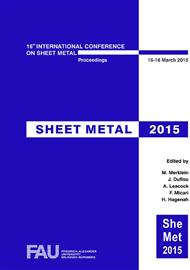p.347
p.353
p.361
p.369
p.377
p.385
p.395
p.403
p.411
Influence of Stress Relaxation after Uniaxial Pre-Straining on Subsequent Plastic Yielding in the Uniaxial Tensile Test of Sheet Metal
Abstract:
Resource efficiency, design oriented accuracy and lightweight properties are demands on modern sheet metal forming parts in the automotive sector. The use of new materials leads to additional challenges on the numerical design of forming processes. During these forming processes the material undergoes different strain states that cause non-linear strain paths. Since the numerical prediction highly depends on the identified characteristic values of the material, an exact characterisation of the material behaviour is essential. Especially obtuse angles of the stress vector trigger a recovery of the material by returning stress. Besides, a relaxation of the material is investigated during holding a constant strain level. The effect of relaxation lead to an altered material behaviour that appears in a reduction of the beginning of plastic yielding. In addition, a kinematic hardening behaviour as under cyclic loading and load reversal, known as the Bauschinger effect, occurs after the relaxation of the stress and results in a reduced beginning of plastic yielding by loading in the same direction as the introduced pre-strain. Within this research work the effect of relaxation is investigated for two materials, AA5182 and DP600, with an initial sheet thickness of 1.0 mm. These materials are typically used for internal and accordingly functional parts in the automotive sector. The relaxation of the material is analysed with different holding times of a constant pre-strain at different levels of straining. The release of the material is studied by subsequent uniaxial tensile tests after pre-straining with the same load condition. Moreover, the influence of the named effects is shown by comparison of the translation of the yield loci.
Info:
Periodical:
Pages:
377-384
Citation:
Online since:
March 2015
Authors:
Keywords:
Price:
Сopyright:
© 2015 Trans Tech Publications Ltd. All Rights Reserved
Share:
Citation:


